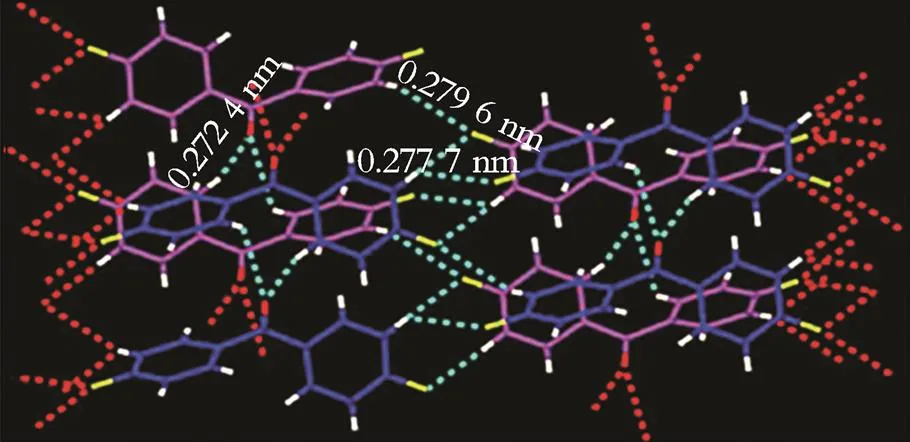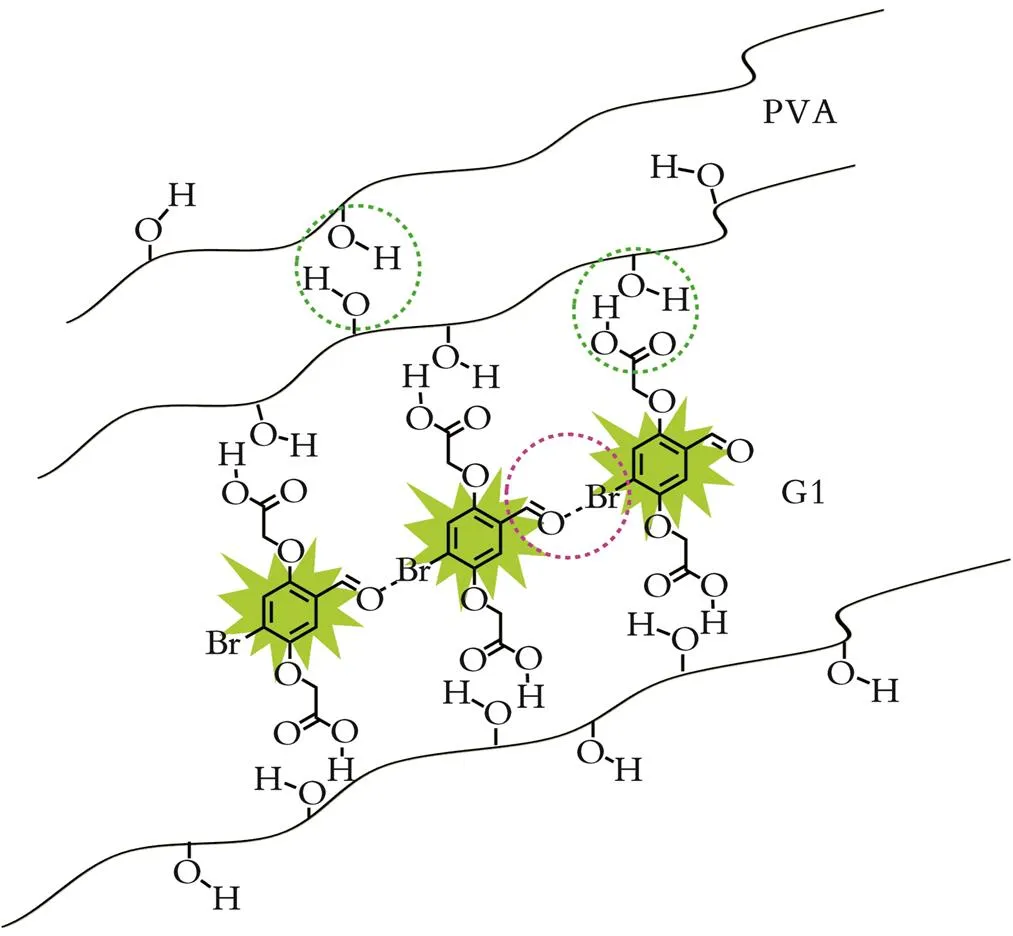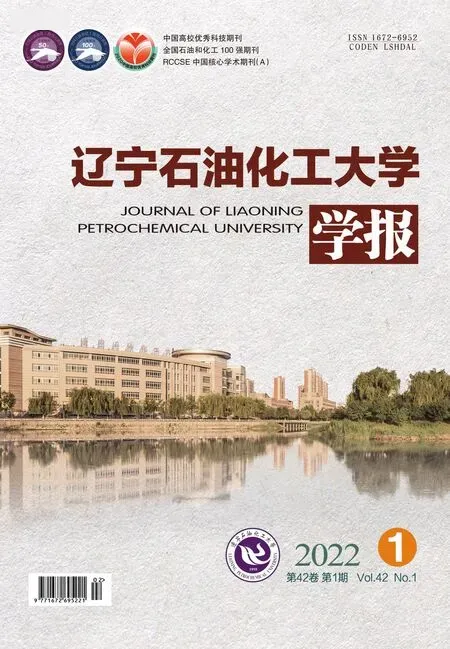有机磷光体系及其研究进展
陈望彬,周世嘉,张晓朕,尹禹翰,苍书宇,欧贤,代广福,王晓蓉
有机磷光体系及其研究进展
陈望彬1,周世嘉2,张晓朕1,尹禹翰1,苍书宇1,欧贤1,代广福1,王晓蓉1
(1.辽宁石油化工大学 石油化工学院,辽宁 抚顺 113001; 2.抚顺市生态环境事务服务中心,辽宁 抚顺 113006)
室温磷光性有机物由于三重态激子的参与和相对较慢的衰变速率,使其具有较长波长及长寿命的特性,让该类型化合物在光学器件、光催化反应、生物成像等领域中具有广泛的应用前景。目前构筑室温磷光有机体系主要是通过促进自旋轨道耦合和抑制三重态到基态的非辐射衰变来完成。对近年来室温磷光有机体系的发展进行归纳和总结,针对如何设计室温磷光有机体系提出了几种方法,并分析其原理,对未来室温磷光有机体系的发展与应用进行了展望。
室温磷光; 耦合; 非辐射衰变
随着发光性物质在日常生活及其他领域中应用越来越广泛,磷光材料因其具有寿命长、stokes位移值大以及易被检测等优势,已成为发光材料领域中重要的研究方向之一[1⁃4]。能够发射出磷光的化合物或混合物都存在激发三重态,这使被激发的电子可以进行相对长距离的跃迁,更容易产生自由电荷。理论上,磷光材料的光量子转化效率可达100%,使其在所有发光物中的地位日益凸显,尤其在生物成像、显示和照明等方面应用更广[5⁃7]。相比于无机磷光化合物(通常为无机和有机金属配合物),有机磷光化合物因不含有金属而显得更为环保和易于制备[8⁃11]。
在室温磷光有机化合物出现以前,有机磷光化合物通常存在于低温、惰性的条件下,这是由于处于激发三重态的有机物极易在振动中与空气中的氧气发生淬灭[12⁃15],这一限制条件使有机磷光化合物在实际应用中发展缓慢。目前,开发磷光有机材料的目标是最大程度地提高磷光量子产率和减少发射光在环境作用下的猝灭,并在室温条件下实现这些特性。提高有机分子室温磷光量子产率的主要手段是通过在有机发光分子内引入重原子、使用重氢原子取代分子内的氢原子、向体系内引入芳香羰基、加强分子间作用力(如通过氢键、形成晶格等方式),或者将发光体作为支链基团引入聚合物材料,直接将可以发射磷光的化合物物理混杂于提供刚性条件的聚合物环境中。
1 磷光的生成
磷光是分子从激发单重态(1)经系间窜越到达激发三重态(1),然后再从激发三重态(1)回到基态(0)的过程(1→0)(见图1),其寿命通常会比荧光长,但是由于此过程通常是禁阻的,所以其可能性相比从激发单重态回到基态(荧光生成过程)而言概率较低。

图1 荧光与磷光产生示意图
为了缓解这种从激发单重态到激发三重态的禁阻过程,相关工作者通常会设计一系列含有自旋轨道耦合作用的分子来提升其系间窜越的概率。当电子以一定的速率绕原子核运动时,会产生一个变化的空间电场;电子本身存在自旋磁矩,该电场与自旋磁矩的相互作用被称之为自旋轨道耦合作用,其实质是为电子自旋与轨道运动产生的作用。在磷光体系中引入重原子和羰基基团能加强这种自旋轨道耦合作用,使分子更容易到达激发三重态。
虽然磷光化合物的磷光量子产率主要与分子结构有关,然而环境因素往往对其发射磷光的现象也产生重要影响。例如,在温度较高的环境中,分子间的相对运动会更加频繁,这会使处于三重态的电子经无辐射弛豫返回至基态。面对这样的情况,通常的做法是把磷光分子固定成刚性体(例如将样品置于液氮之中再进行测定,可称之为低温磷光(LTP)),或者是采用高黏度溶剂、低温刚性玻璃体、室温固体支撑材料、特殊有序介质、溶液充分除氧等途径来降低环境对有机磷光化合物发射磷光行为的影响,从而提高磷光量子产率。
2 有机磷光小分子的研究
1935年,H.Kautsky[16]观察到某些染料在水和丙醇溶液中可以出现磷光现象。1944年,G.N.Lewis等[17]研究结果表明,在磷光分子发射磷光的过程中,激发三重态是其必须经历的过程。20世纪60年代到80年代的相关研究结果表明,在有机磷光化合物中插入重原子或加入羰基基团能提升自旋轨道耦合作用,增加有机磷光化合物从激发单重态经系间窜越至激发三重态的可能性[18⁃22]。1974年,M.L.Saviotti等[23]研究了蛋白质囊内色氨酸分子的磷光特性;1977年,K.Kalyanasundaram等[24]研究了以水为介质,胶束内芳香烃的磷光现象;1984年,S.Scypinski等[25]构筑了环糊精腔内多环芳烃的室温磷光有机化合物;1988年,T.Itoh等[26]研究表明,在像苯甲醛这样的简单化合物中,其在气相中进行系间窜越的几率可达到100%。
2.1 结晶态有机磷光小分子
有机磷光化合物形成晶体后,拥有一个刚性的晶格环境,使分子间的相对运动和分子内振动降低,减少其处于激发三重态的电子经无辐射弛豫返回至基态的概率,因此可以顺利发射磷光。
2010年,W.Z.Yuan等[27]合成一系列二苯甲酮以及其衍生物(X-C6H4)2C=O(X=F, Cl, Br)和4⁃溴苯甲酸甲酯、4,4′⁃二溴联苯,结晶后发现其在室温下发射磷光。如图2所示,晶体内分子与分子之间通过氢键紧密排列在一起,经过激发光照射之后,能于室温中观测到明显的磷光现象[27⁃31]。

图2 对二(4⁃氟苯基)甲酮晶体中分子堆积排列的模拟示意图(虚线为氢键)
2019年,唐亮亮[32]合成了一系列三联吡啶衍生物THPD(4'⁃(4⁃(1,3,2⁃二氧杂硼杂环⁃2⁃基)苯基)⁃2,2'∶6',2''⁃三联吡啶)、NG(4'⁃(4⁃(5,5⁃二甲基⁃1,3,2⁃二氧杂硼杂环⁃2⁃基)苯基)⁃2,2'∶6',2''⁃三联吡啶)、PD(三联吡啶苯硼酸)和EG(4'⁃(4⁃(1,3,2⁃二氧硼戊环⁃2⁃基)苯基)⁃2,2'∶6',2''⁃三联吡啶)。结果表明,三联吡啶衍生物在溶于四氢呋喃时并未发射出磷光;当THPD和NG结晶后,在500 nm左右能得到磷光峰,而PD和EG由于难以结晶而不能发射出磷光。
(3) 设鸟蛋被发现概率为Ra(Ra∈[0,1]),Ra越大表示该鸟蛋存在更大机率被筑巢鸟丢弃,或是直接寻找新的一处构筑新的鸟巢位置。
2.2 含羰基有机磷光小分子
在磷光体系中引入羰基基团能促进该分子的自旋轨道耦合作用,使电子从激发单重态到激发三重态的禁阻过程变得可能,从而提高该分子的磷光量子产率。
2015年,Y.Y.Gong等[33]合成了芳香酸TFTPA和芳香酯DMTFTPA。芳香酸TFTPA,在芳香烃的侧链上有效地插入了羰基基团,加强了其自旋轨道耦合作用,使磷光分子更容易到达激发三重态;其羧基还能提供强有力的分子间氢键作用,使该分子结晶后分子排列缜密,降低因分子振动所导致的处于激发三重态分子无辐射失活概率,使其磷光量子产率更为出色。芳香酯DMTFTPA,虽没有形成如芳香酸TFTPA般强的氢键作用,但通过对其进行结晶处理后,该晶体拥有了3D网络结构,这也令其分子振动减少,从而降低其处于激发三重态分子无辐射失活的概率,故该晶体的发光效率并不比芳香酸TFTPA低。
同年,P.C.Xue[34]构筑了一种可以稳定发射室温磷光的纯有机化合物CBA(无重原子),其使用廉价的咔唑作为母环,并且在该化合物中引入羰基基团来加强了自旋轨道耦合作用。此设计使该化合物在经结晶与研磨后,在空气中仍可以发射出稳定的磷光,并且其寿命达到了540.00 ms。此外,该化合物在机械力的作用(固态结构遭到破坏)下,处于激发三重态的分子可以受到环境的影响发生淬灭,磷光转变为荧光。
在同样的机理下,2018年,Z.Z.Zhang等[35]合成了化合物BrPh2OAc、BrPh2OH和BrPh2Cz。结果表明,3种有机物在室温下溶于四氢呋喃时并未发射出磷光,而当其结晶后,在室温下就能发射出明亮的磷光,其中BrPh2Cz的寿命甚至可以达到317.00 ms。
2.3 共晶态有机磷光小分子
对某些有机磷光分子而言,其结构决定了该化合物难以形成单晶,这时可以采取共晶的方式提供一个刚性的晶格环境,其效果和单晶相差无几,甚至更佳。
2011年,O.Bolton等[36]利用该原理合成了分子Br6A(2,5⁃二己氧基⁃4⁃溴苯(甲)醛)。在Br6A中,通过重原子Br和羰基来加强分子的自旋轨道耦合作用,以增加其达到激发三重态的概率。通过将Br6A进行结晶,赋予了刚性的环境,降低处于激发三重态分子的无辐射失活概率,因此观测到明亮的室温磷光现象(见图3)。但是,Br6A会进行自猝灭,这使磷光量子产率仅为2.9%。为了减少其自猝灭作用,将Br6A稀释于基底化合物Br6中,Br6A和Br6形成共晶后,测得其室温磷光量子产率高达55.0%。

图3 Br6A和Br6形成的共晶体受365 nm光激发后发射磷光的照片
2012年,Q.J.Shen等[37]将化合物1,4⁃DITFB与多芳香烃类化合物(萘和菲)形成共晶体,由于重原子效应,分子的自旋轨道耦合作用得到加强,再加上晶态给予的刚性环境,降低处于激发三重态分子无辐射失活的概率,从而使化合物更好地发射磷光。2013年,X.Pang等[38]将化合物1,4⁃DBrTFB与菲形成共晶体,也观察到了其晶体发射磷光的现象,而且在不同的激发波长下能调节所发射的磷光波长。
3 室温磷光聚合物的研究
聚合物具有相对分子质量大、链长、易形成线圈的特点,并且制成材料后宏观上具有一定的刚性。此外,聚合物的缠绕结构可以有效地隔离氧和其他外界环境因素的影响,因此以聚合物为基体的磷光材料可以降低处于激发三重态能量的消耗[39⁃40]。近年来,由于室温磷光小分子的高速发展,使相关工作者发现一系列可以有效发射磷光的基团。这些功能基团作为聚合物的客体、侧链、主链或末端基团,可被聚合物基底有效地抑制其分子内振动,从而成功地实现室温磷光特性。此外,以聚合物为基体的室温磷光材料在为内部发光基团提供刚性骨架与保护环境的同时,又具备柔韧性、可拉伸性以及易加工等特点,这使室温磷光聚合物的引入对室温磷光材料的发展具有非常重要的实际意义。
3.1 物理包裹
物理包裹是将可以发射磷光的有机小分子直接掺杂在高分子中,利用高分子材料的刚性特点给予有机磷光小分子一个优越的环境,令其达到室温磷光的效果。
如图4所示,有机磷光小分子化合物G1嵌入聚合物基体PVA中,形成非晶态的室温磷光聚合物体系[41]。其内部存在多种分子间相互作用力,包括聚合物基体之间的氢键、有机磷光小分子与聚合物基底之间的氢键和一个有机磷光小分子的芳香羰基与另外一个相同有机磷光小分子的重原子Br形成的卤键,这些强分子间相互作用力和刚性的环境对室温磷光的产生具有重要的作用。

图4 G1嵌入PVA中的结构示意图(绿色虚线圈为氢键,玫红色虚线圈为卤键)
2018年,Y.Su等[42]利用PVA的易交联特性成功地提高了6⁃(4⁃羧基⁃苯氧基)⁃环三磷腈的室温磷光效应。6⁃(4⁃羧基⁃苯氧基)⁃环三磷腈有6个延伸的芳香羰基,可以提供足够的轨道来触发从1到n的系间窜越(ISC)过程,羧基基团还可以与PVA交联结构形成氢键。当无光照射时,其磷光寿命和磷光量子产率只有0.28 s和2.85%;接受254 nm光照射65 min后,其磷光寿命和磷光量子产率可以达到0.71 s和11.23%。因此,在外部刺激下引入交联的聚合物基体,可提供刚性的包裹坏境,以此来提高室温磷光效果。
除了使用聚合物充当刚性基体外,聚合物基体材料还可以与有机磷光小分子相互作用形成激态络合物,从而大幅度地延长室温磷光化合物的寿命[42⁃43]。2018年,K.Jinnai等[43]完成了开创性的工作,即以TMB(N4,N4,N4',N4'⁃四甲基⁃(1,1'⁃联苯基)⁃4,4'⁃二胺)(摩尔分数为1%)为电子供体,以聚芳醚氧化膦(摩尔分数为99%)为电子受体,在室温低功率条件下激发,其磷光寿命超过7.00 min。这种超长发光现象主要是因为两者之间形成了局部激态络合物,形成了长寿命的电荷分离态,极大地延长了激子的寿命。
3.2 化学合成
化学合成是将潜在可以发射磷光的基团以共价键的形式连接在聚合物中,其基团可以存在于聚合物主链或者侧链上,对于某些特殊的聚合物,其磷光基团也可以以末端基团的形式存在。
2007年,G.Q.Zhang等[44]首先使用这种方法对聚合物进行设计,利用二氟化硼二苯甲酰甲烷(BF2dbm)作为聚乳酸的末端基团,发现产物的磷光量子产率显著增强,并且观察到了室温磷光现象。这表明聚合物的缠绕结构可以有效地锁住位于聚合物末端的磷光二氟化硼二苯甲酰甲烷基团,使其通过振动而导致的非辐射能量逸散程度降低。
2015年,C.A.Derosa等[45]合成了一系列的取代卤化物BF2dbm(X)PLA(X=H,F,Cl,Br,I),通过重原子效应有效地调节聚合物的激发三重态发射。在氮气气氛下,含较轻卤化物取代基(F和Cl)的聚合物发射磷光较弱,但其寿命超过100.00 ms;含较重卤化物取代基(Br和I)的聚合物发射磷光较强,但其寿命小于50.00 ms。这说明在聚合物体系中,重原子效应依旧有效,且表现为取代基越重(原子序数越大),聚合物发射的磷光越强,寿命越短。
H.Chen等[46]将丙烯酰胺单体与可发射磷光的单体(2⁃溴⁃5⁃羟基苯甲醛衍生物BrBA、α⁃溴萘衍生物BrNp和4⁃溴⁃1,8⁃萘酐衍生物BrNpA)进行二元共聚(见图5)。结果表明,在常温下,磷光量子产率分别为11.4%、8.4%和7.4%。本研究为构建高效率的纯有机室温磷光聚合物体系提供了一种简便的方法。

图5 二元共聚物结构式
2015年,C.Zhou等[47]将胺基取代的二苯甲酮以小比例共价结合到水性聚氨酯(WPU)中,并在室温下成功地实现了荧光和磷光的双重发射。将胺基取代的二苯甲酮以质量分数1%掺入聚合物中时,所得的聚合物荧光在445 nm处达到峰值,磷光波长位于505 nm处,这表明在主链上添加潜在发射磷光的基团是开发室温磷光聚合物的有效方法。
4 总结与展望
具有长寿命三线态激子的室温磷光(RTP)材料在数据加密、电子传感以及医学显像等领域应用广泛。目前,在小分子的设计上通常采用D⁃π⁃A结构、引入卤素、增强分子间作用力等来实现有效的磷光发射,然而绝大部分有机磷光小分子都需具备晶格特征,且对环境的要求也偏高,这些问题都极大地限制了RTP材料的实际应用。因此,以聚合物为基的RTP纯有机材料在为内部发光基团提供刚性骨架与保护环境的同时,又具备柔韧性、可拉伸性以及易加工等特点,近年来受到学术界与产业界的广泛关注。
因此,研发有效的RTP有机小分子,同时让其从小分子体系中走出来,化学与材料相结合,用以构筑具有实用价值RTP聚合物材料,利用结构与性能的关系,实现对材料性能的调控,研究聚合物内部发光机理,拓展其应用领域,很有可能成为此领域下一个十年的发展方向。
[1] Mukherjee S, Thilagar P. Recent advances in purely organic phosphorescent materials[J]. Chemical Communications, 2015, 51(55): 10988⁃11003.
[2] Hirata S. Recent advances in materials with room‐temperature phosphorescence: Photophysics for triplet exciton stabilization[J]. Advanced Optical Materials, 2017, 5(17): 1700116.
[3] Xu S, Chen R, Zheng C. Excited state modulation for organic afterglow: Materials and applications[J]. Advanced Materials, 2016, 28(45): 9920⁃9940.
[4] Ryota K, Naoto N, Kou Y, et al. Afterglow organic light⁃emitting diode[J]. Advanced Materials, 2016, 28(4):655⁃660.
[5] Yang J, Zhen X, Wang B, et al. The influence of the molecular packing on the room temperature phosphorescence of purely organic luminogens[J]. Nature Communications, 2018, 9(1): 840.
[6] Yang J, Gao X , Xie Z, et al. Elucidating the excited state of mechanoluminescence in organic luminogens with room⁃temperature phosphorescence[J]. Angewandte Chemie International Edition, 2017, 129(48): 15501⁃15505.
[7] Chai Z F, Wang C, Wang J F, et al. Abnormal room temperature phosphorescence of purely organic boron⁃containing compounds: The relationship between the emissive behavior and the molecular packing, and the potential related applications[J]. Chemical Science, 2017, 8(12): 8336⁃8344.
[8] Xie Y J, Ge Y W, Peng Q, et al. How the molecular packing affects the room temperature phosphorescence in pure organic compounds: Ingenious molecular design, detailed crystal analysis, and rational theoretical calculations[J]. Advanced Materials, 2017, 29(17): 1606829.
[9] Xie Y J, Li Z. Thermally activated delayed fluorescent polymers[J]. Journal of Polymer Science Part A: Polymer Chemistry, 2017, 55(4): 575⁃584.
[10] Fang X Y, Yan D P. White⁃light emission and tunable room temperature phosphorescence of dibenzothiophene[J]. Science China Chemistry, 2018, 61(4): 397⁃401.
[11] Li K X, Zhao L F, Gong Y Y,et al. A gelable pure organic luminogen with fluorescence⁃phosphorescence dual emission[J]. Science China Chemistry, 2017, 60(6): 136⁃142.
[12] Kimura T, Watanabe S, Sawada S I, et al. Preparation and optical properties of polyimide films linked with porphyrinato Pd (II) and Pt (II) complexes through a triazine ring and application toward oxygen sensors[J]. Journal of Polymer Science Part A: Polymer Chemistry, 2017, 55(6): 1086⁃1094.
[13] Liu H C, Gao Y, Cao J G, et al. Efficient room⁃temperature phosphorescence based on pure organic sulfur⁃containing heterocycle: Folding⁃induced spin⁃orbit coupling enhancement[J]. Materials Chemistry Frontiers, 2018, 2(10): 1853⁃1858.
[14] Tao S Y, Lu S Y, Geng Y J, et al. Design of metal⁃free polymer carbon dots: A new class of room⁃temperature phosphorescent materials[J]. Angewandte Chemie International Edition, 2018, 57(9): 2393⁃2398.
[15] Ma X, Xu C, Wang J, et al. Amorphous pure organic polymers for heavy⁃atom⁃free efficient room⁃temperature phosphorescence emission[J]. Angewandte Chemie International Edition, 2018, 130(34): 10854⁃10858.
[16] Kautsky H. Energie⁃umwandlungen an grenzflächen, VIII. mitteil.: H. Kautsky, A. Hirsch und W. Flesch: Die bedeutung metastabiler zustände für sensibilisierte photo⁃oxydationen[J]. Berichte Der Deutschen Chemischen Gesellschaft, 1935, 68(1): 152⁃162.
[17] Lewis G N, Kasha M. Phosphorescence and the triplet state[J]. Journal of the American Chemical Society, 1944, 66(12): 2100⁃2116.
[18] Seybold P G, White W. Room temperature phosphorescence analysis. Use of the external heavy⁃atom effect[J]. Analytical Chemistry, 1975, 47(7): 1199⁃1200.
[19] Winnik M A, Lemire A, Saunders D S, et al. Phosphorescence of substituted benzophenones in solution. Probes for the conformation of hydrocarbon chains in polar and proticsolvents[J]. Journal of the American Chemical Society, 1976, 98(7): 2000⁃2002.
[20] Winnik M A, Basu S N, Lee C K, et al. Phosphorescence of substituted benzophenones in solution. A probe of hydrocarbon chain conformation in three nonpolar solvents[J]. Journal of the American Chemical Society, 1976, 98(10): 2928⁃2935.
[21] Schulman E M, Parker R T. Room temperature phosphorescence of organic compounds. The effects of moisture, oxygen, and the nature of the support⁃phosphor interaction[J]. The Journal of Physical Chemistry, 1977, 81(20): 1932⁃1939.
[22] Boduszynski M M, Hurtubise R J, Allen T W. Liquid chromatography/field ionization mass spectrometry in the analysis of high⁃boiling and nondistillable coal liquids for hydrocarbons[J]. Analytical Chemistry, 1983, 55(2): 225⁃231.
[23] Saviotti M L, Galley W C. Room temperature phosphorescence and the dynamic aspects of protein structure[J]. Proceedings of the National Academy of Sciences, 1974, 71(10): 4154⁃4158.
[24] Kalyanasundaram K, Grieser F, Thomas J K. Room temperature phosphorescence of aromatic hydrocarbons in aqueous micellar solutions[J]. Chemical Physics Letters, 1977, 51(3): 501⁃505.
[25] Scypinski S, Love L J C. Room temperature phosphorescence of polynuclear aromatic hydrocarbons in cyclodextrins[J]. Analytical Chemistry, 1984, 56(3): 322⁃327.
[26] Itoh T. The evidence showing that the intersystem crossing yield of benzaldehydevapour is unity[J]. Chemical Physics Letters, 1988, 151(1⁃2): 166⁃168.
[27] Yuan W Z, Shen X Y, Zhao H. Crystallization⁃induced phosphorescence of pure organic luminogens at room temperature[J]. Journal of Physical Chemistry C, 2010, 114(13): 6090⁃6099.
[28] Gong Y Y, Tan Y Q, Mei J, et al. Room temperature phosphorescence from natural products: Crystallization matters[J]. Science China Chemistry, 2013,56(9): 1178⁃1182.
[29] Gong Y Y, Chen G, Peng Q,et al. Achieving persistent room temperature phosphorescence and remarkable mechanochromism from pure organic luminogens[J]. Advanced Materials, 2015, 27(40):6195⁃6201.
[30] Gong Y Y, Zhao L, Peng Q,et al. Crystallization⁃induced dual emission from metal⁃ and heavy atom⁃free aromatic acids and esters[J]. Chemical Science, 2015, 6(8): 4438⁃4444.
[31] Li J, Jiang Y, Cheng J. Tuning the singlet⁃triplet energy gap of AIE luminogens: Crystallization⁃induced room temperature phosphorescence and delay fluorescence, tunable temperature response, highly efficient non⁃doped organic light⁃emitting diodes[J]. Physical Chemistry Chemical Physics: PCCP, 2015, 17(2): 1134⁃1141.
[32] 唐亮亮. 具有刺激响应行为的有机材料合成与性质研究[D]. 青岛:青岛科技大学, 2019.
[33] Gong Y Y, Zhao L, Peng Q. Crystallization⁃induced dual emission from metal⁃ and heavy atom⁃free aromatic acids and esters[J]. Chemical Science, 2015, 6(8): 4438⁃4444.
[34] Xue P C. Luminescence switching of a persistent room⁃temperature phosphorescent pure organic molecule in response to external stimuli[J]. Chemical Communications, 2015, 51(52): 10381⁃10384.
[35] 张振振. 基于咔唑的纯有机室温磷光材料的设计合成及光学性质研究[D]. 青岛:青岛科技大学,2019.
[36] Bolton O, Lee K, Kim H J, et al. Activating efficient phosphorescence from purely organic materials by crystal design[J]. Nature Chemistry, 2011, 3(3): 207⁃212.
[37] Gao H Y, Shen Q J, Zhao X R, et al. Phosphorescent co⁃crystal assembled by 1,4⁃diiodotetrafluorobenzene with carbazole based on C–I···π halogen bonding[J]. Journal of Materials Chemistry, 2012, 22(12): 5336.
[38] Pang X, Wang H, Zhao X R, et al. Co⁃crystallization turned on the phosphorescence of phenanthrene by C-Br···π halogen bonding,π⁃hole···π bonding and other assisting interactions[J]. CrystEngComm, 2013, 15(14): 2722⁃2730.
[39] Gan N, Shi H F, An Z F, et al. Recent advances in polymer‐based metal‐free room‐temperature phosphorescent materials[J]. Advanced Functional Materials, 2018, 28(51): 1802657.
[40] Wu W B, Tang R L, Li Q Q, et al. Functional hyperbranched polymers with advanced optical, electrical and magnetic properties[J]. Chemical Society Reviews, 2015, 44(12): 3997⁃4022.
[41] Min S K, Lee D, Seo S, et al. Tailoring intermolecular interactions for efficient room⁃temperature phosphorescence from purely organic materials in amorphous polymer matrices[J]. Angewandte Chemie, 2014, 126(42): 11177⁃11181.
[42] Su Y, Phua S Z F, Li Y B, et al. Ultralong room temperature phosphorescence from amorphous organic materials toward confidential information encryption and decryption[J]. Science Advances, 2018, 4(5): eaas9732.
[43] Jinnai K, Kabe R, Adachi C. Wide⁃Range tuning and enhancement of organic long⁃persistent luminescence using emitter dopants[J]. Advanced Materials, 2018, 30(38): 1800365.
[44] Zhang G Q, Chen J B, Sarah J P, et al. Multi⁃emissive difluoroboron dibenzoylmethane polylactide exhibiting intense fluorescence and oxygen⁃sensitive room⁃temperature phosphorescence[J]. Journal of the American Chemical Society, 2007, 129(29): 8942⁃8943.
[45] DeRosa C A, Kerr C, Fan Z, et al. Tailoring oxygen sensitivity with halide substitution in difluoroboron dibenzoylmethane polylactide materials[J]. ACS Applied Materials & Interfaces, 2015, 7(42): 23633⁃23643.
[46] Chen H, Yao X Y, Ma X, et al. Amorphous, efficient, room⁃temperature phosphorescent metal⁃free polymers and their applications as encryption ink[J]. Advanced Optical Materials, 2016, 4(9): 1397⁃1401.
[47] Zhou C, Xie T Q, Zhou R, et al. Waterborne polyurethanes with tunable fluorescence and room⁃temperature phosphorescence[J]. ACS Applied Materials & Interfaces, 2015, 7(31): 17209⁃17216.
Organic Phosphorescent System and Its Research Progress
Chen Wangbin1, Zhou Shijia2, Zhang Xiaozhen1, Yin Yuhan1, Cang Shuyu1, Ou Xian1, Dai Guangfu1, Wang Xiaorong1
(1.School of Petrochemical Engineering, Liaoning Petrochemical University, Fushun Liaoning 113001, China;2.Ecological and Environmental Affairs Service Center, Fushun Liaoning 113006, China)
In recent years, light⁃emitting organics have attracted widespread attention due to their unique functions. Among them, room temperature phosphorescent organics have the characteristics of longer wavelength and long life due to their triplet excitons and relatively slow decay rate, resulting in a wide range of application prospects in optical devices, photocatalytic reactions and other fields. At present, the construction of room temperature phosphorescent organic system is mainly accomplished by promoting spin⁃orbit coupling and suppressing the non⁃radiative decay process from the triplet state to the ground state. This article summarized the development of room temperature phosphorescent organic system in recent years. According to how to design room temperature phosphorescent organic system, several methods were proposed and their principles were analyzed, and the future development and application of room temperature phosphorescence organic system were prospected.
Room temperature phosphorescence; Coupling; Non⁃radiative decay
TE09
A
10.3969/j.issn.1672⁃6952.2022.01.006
1672⁃6952(2022)01⁃0028⁃07
2020⁃10⁃06
2020⁃11⁃23
辽宁省教育厅优青培育项目(L2020032);辽宁石油化工大学引进人才科研启动基金项目(2016XJJ⁃010);江南大学合成与生物胶体教育部重点实验室开放研究课题基金项目(JDSJ2018⁃05);四川大学高分子材料工程国家重点实验室开放课题基金项目(sklpme2019⁃4⁃24)。
陈望彬(1996⁃),男,硕士研究生,从事光功能小分子的设计与合成研究;E⁃mail:973891195@qq.com。
王晓蓉(1985⁃),女,博士,副教授,从事光功能有机小分子与聚合物的设计与合成研究;E⁃mail:wangxiaorong@lnpu.edu.cn。
http://journal.lnpu.edu.cn
(编辑 宋官龙)

